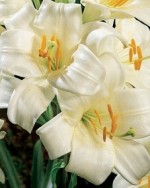 True lilies are one of the most showy plants found in cottage gardens. True lilies all belong to the genus Lilium so many plants that have the word “lily’ as part of their name aren’t lilies at all. This means that daylilies, water lilies, lilies of the valley and many other popular garden flowers are not included in the term “true lilies”.
True lilies are one of the most showy plants found in cottage gardens. True lilies all belong to the genus Lilium so many plants that have the word “lily’ as part of their name aren’t lilies at all. This means that daylilies, water lilies, lilies of the valley and many other popular garden flowers are not included in the term “true lilies”.
The appeal of the true lilies goes way back in time. The Minoans depicted lilies in their frescos 3500 years ago in Crete. The ancient Egyptians used lilies in funeral wreaths, and both the ancient Greeks and Romans associated the lily with the Queen of their gods. Christians continued the ancient idea and used the lily to symbolize the purity of Mary. The introduction of lilies from the East added many new varieties to European gardens and most of the lilies we see for sale in stores and catalogs are the hybrids. Yet, some of the lilies that were traditionally grown in cottage gardens can still be found and are well worth growing. Here are five true lilies to consider.
 Madonna Lily (Lilium candidum)
Madonna Lily (Lilium candidum)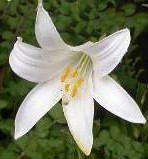 Perhaps the earliest lily known, cultivated and depicted by the Minoans, the madonna lily is also the one that Renaissance painters such as Botticelli chose to include in their works. Ten to twenty flowers are borne on a stem and face outward displaying their beautiful yellow “stamens. Each flower is 3-4” long and wide and has a delicate sweet fragrance. Unlike most bulbs, this one should be planted only 1” deep.
Perhaps the earliest lily known, cultivated and depicted by the Minoans, the madonna lily is also the one that Renaissance painters such as Botticelli chose to include in their works. Ten to twenty flowers are borne on a stem and face outward displaying their beautiful yellow “stamens. Each flower is 3-4” long and wide and has a delicate sweet fragrance. Unlike most bulbs, this one should be planted only 1” deep.
-
Origin: Eastern Mediterranean
Flower Color: White
Flower Shape: Trumpet
Height: 2-4’
Flowering Time: June
Hardiness: Zones 4-9
 Regal Lily (Lilium regale)
Regal Lily (Lilium regale)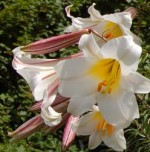 A relative new comer to the cottage garden, the regal lily was discovered in western Szechwan in 1903 and quickly became popular. Wine colored buds open to large 5-6” white flowers with canary yellow throat. Each stems carries 10-20 fragrant flowers making a stunning display.
A relative new comer to the cottage garden, the regal lily was discovered in western Szechwan in 1903 and quickly became popular. Wine colored buds open to large 5-6” white flowers with canary yellow throat. Each stems carries 10-20 fragrant flowers making a stunning display.
-
Origin: China
Flower Color: White with yellow throat
Flower Shape: Trumpet
Height: 4-6’
Flowering Time: July, August
Hardiness: Zones 3-8
 Goldband Lily (Lilium auratum)
Goldband Lily (Lilium auratum)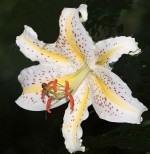 The goldenband sets this lily apart from other white lilies. The fragrant flowers are 6-10” in diameter and are borne horizontally, 5-15 blossoms on each stem. Introduced from Japan in 1862, where they grew on volcanic ash and lava debris, they were immediately popular. Unfortunately they are short lived and have to be replaced every few years.
The goldenband sets this lily apart from other white lilies. The fragrant flowers are 6-10” in diameter and are borne horizontally, 5-15 blossoms on each stem. Introduced from Japan in 1862, where they grew on volcanic ash and lava debris, they were immediately popular. Unfortunately they are short lived and have to be replaced every few years.
-
Origin: Japan
Flower Color: White with yellow band
Flower Shape: Bowl
Height: 2-4’
Flowering Time: August, September
Hardiness: Zones 4-9
 Martagon Lily (Lilium martagon)
Martagon Lily (Lilium martagon)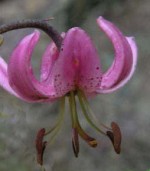 The name of this lily probably comes from the Turkish word for a special kind of turban worn by Sultans and another common name for the plant is Turk’s cap lily. The strongly recurved petals and the shear mass of flowers on each stem give this lily a unique look. It is a very adaptable lily and can tolerate considerable shade
The name of this lily probably comes from the Turkish word for a special kind of turban worn by Sultans and another common name for the plant is Turk’s cap lily. The strongly recurved petals and the shear mass of flowers on each stem give this lily a unique look. It is a very adaptable lily and can tolerate considerable shade
-
Origin: Europe, Asia
Flower Color: Purple-red with dark purple spots
Flower Shape: Nodding
Height: 3-4’
Flowering Time: June, July
Hardiness: Zones 3-8
 Pyrenean Lily/ Yellow Turk’s cap lily(Lilium pyrenaicum)
Pyrenean Lily/ Yellow Turk’s cap lily(Lilium pyrenaicum)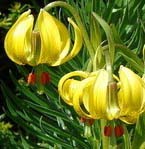 Resembling Lilium martagon in the form of its flower, L. pyrenaicum differs in both height and color, and can contribute hot colors to the cottage garden. Twelve flowers borne on each stem. This is not a lily to plant near a favorite bench as the flowers have a disagreeable scent.
Resembling Lilium martagon in the form of its flower, L. pyrenaicum differs in both height and color, and can contribute hot colors to the cottage garden. Twelve flowers borne on each stem. This is not a lily to plant near a favorite bench as the flowers have a disagreeable scent.
-
Origin: Montane areas of Spain, mainly the Pyrenees Mountains, east to the Caucasus Mountains.
Flower Color: Yellow, orange, or red sometimes with purple spotted throats
Flower Shape: Nodding
Height: 1-3’
Flowering Time: June, July
Hardiness: 4-7
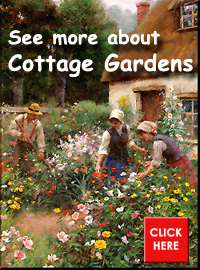 There are many true lilies that would give a similar look to a cottage garden and many of them are readily available in stores and catalogs. The asiatic and oriental hybrids are especially easy to find and most are easy to grow. Areas east of the Rocky Mountains are better for some lilies, while areas in the west are better for others so check your local nurseries and botanic gardens to see what will do well in your garden before buying from catalogs.
There are many true lilies that would give a similar look to a cottage garden and many of them are readily available in stores and catalogs. The asiatic and oriental hybrids are especially easy to find and most are easy to grow. Areas east of the Rocky Mountains are better for some lilies, while areas in the west are better for others so check your local nurseries and botanic gardens to see what will do well in your garden before buying from catalogs.